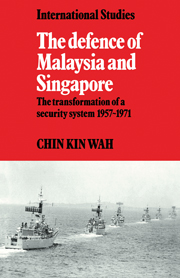Book contents
- Frontmatter
- Contents
- Preface
- Acknowledgements
- List of abbreviations
- Note on currency units
- 1 Introduction
- 2 Pre-treaty defence relations
- 3 Decolonisation and the institution of the defence agreement
- 4 The extension of AMDA
- 5 The external testing of AMDA
- 6 Towards a closing of ranks
- 7 The fractured axis
- 8 Britain weighs anchor
- 9 From AMDA to the five-power defence system
- 10 Conclusions
- Postscript on five-power arrangements
- Notes
- Bibliography
- Index
Postscript on five-power arrangements
Published online by Cambridge University Press: 07 October 2011
- Frontmatter
- Contents
- Preface
- Acknowledgements
- List of abbreviations
- Note on currency units
- 1 Introduction
- 2 Pre-treaty defence relations
- 3 Decolonisation and the institution of the defence agreement
- 4 The extension of AMDA
- 5 The external testing of AMDA
- 6 Towards a closing of ranks
- 7 The fractured axis
- 8 Britain weighs anchor
- 9 From AMDA to the five-power defence system
- 10 Conclusions
- Postscript on five-power arrangements
- Notes
- Bibliography
- Index
Summary
Following the coming into effect of the Five-Power Defence Arrangements in November 1971, the forces of the external powers were reconstituted as follows:
Australia
2 squadrons of about 40 Mirage fighter aircraft based at Butterworth, Malaysia (HQ of the IADS)
6–8 Mirages, drawn from the above 40, based at Tengah (Singapore)
1 infantry battalion in Singapore
1 destroyer or frigate and 1 submarine in rotation with the UK
New Zealand
1 infantry battalion in Singapore
1 frigate
Transport aircraft and a contribution of HQ and logistical personnel to the IADS
Occasional deployment of air units
Britain
1 infantry battalion in Singapore
Up to 6 frigates
Up to 4 Nimrod maritime reconnaissance aircraft
1 squadron of Whirlwind helicopters
Combat units, ships and aircraft on visits
1 submarine in rotation with Australia
The combined Australian, New Zealand and United Kingdom (ANZUK) force totalled 7,000 men, of whom about 3,300 were Australians, 4,150 New Zealanders and 2,550 British. These forces were the direct responsibility of the ANZUK Commander, who was answerable to the Chiefs of Staff of the three external powers in accordance with the directives approved by their governments.
Within a year of the establishment of these forces, a change of government in Australia was to result in a fundamental alteration to the existing well-balanced force structure. In late 1972 the ALP under Gough Whitlam won office after years in the political wilderness.
- Type
- Chapter
- Information
- The Defence of Malaysia and SingaporeThe Transformation of a Security System 1957–1971, pp. 192 - 194Publisher: Cambridge University PressPrint publication year: 1982

